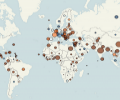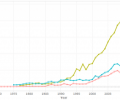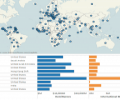Remittances are among the most tangible links between migration and development. They are larger than foreign direct investment and official development assistance received by low- and middle-income countries. In 2022, low- and middle-income countries received $647 billion in remittances via official channels, the World Bank estimates.
The tools below present data on remittances. Select one of the maps below to visualize global remittance flows between 1980 and 2022, numerically or as a share of GDP. Learn about remittance trends since 1980 and the relationships between remittance-sending and -receiving countries.
Note: Remittances are the sum of two components: 1) the total income of migrant workers and other international migrants; and 2) personal transfers (cash and in-kind transfers) between residents and nonresidents. Read more about definitions and the data compiled by the World Bank here: https://migrationdataportal.org/themes/remittances. The World Bank data only capture remittances sent through formal channels such as banks and money transfer operators. Currently, no uniform and authoritative historical data on informal flows exist. Given the widespread use of informal channels, the data should be regarded as underestimates of total flows.
 |
Total Remittance Inflows and Outflows, 1980 - Present
View total remittance inflows and outflows by country since 1980. Remittance volume is displayed either by current U.S. dollar value or as a share of total gross domestic product. Countries are also colored according to whether they are majority remittance-receiving or remittance-sending. |
 |
Remittance Trends over Time, 1980 - Present
This time series shows annual remittance inflows and outflows by country from 1980 to present (either current U.S. dollar value or share of total gross domestic product). Multiple countries can be selected and compared. |
 |
Bilateral Remittance Flows
This data tool displays the remittance flows between countries and also provides estimates of the relevant international migrant population. For example, when displaying remittance inflows, the receiving country's emigrant population in the sending country is given. |
|




